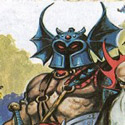|
Thanks for the excellent thread. In reading through it, I think it kind of speaks a bit to a couple of question that I have always wondered about when watching movies/documentaries on warfare during the Medieval period: How did anyone walk away from a Medieval battle without some form of crazy grievous injury? Much like the classical era, It seems like warfare at the time could be a swirling mass of confusion and death, and that with whole units of footman engaged against other units (sometimes after a charge), combat could last an unknown amount of time and be completely exhausting (as Vigilance and others mention). You stated that the knight trained extensively and was an athlete. That kind of explains the ability to swing a sword, or axe, or halberd for long periods of time in armor. Adrenaline would be another factor. You also mentioned the tactics like a shield wall, and formations staying in good order, which would also play a part in keeping troops protected. Even so, I have always wondered how in that exhausting, confusing mass of bodies, almost everyone would be a target for someone else who they were not ready for - someone coming up from behind them and stabbing them while they were engaged with another enemy, someone finishing off an enemy, and smashed in the head by one of his allies, etc. The close in-nature of warfare at the time, and the weapons used also point to downright nasty wounds being commonplace. In your studies, I just wanted to know if you have noticed any trends in battles that might help explain how the average footman could hope to walk away from any given battle without the loss of a limb or worse? Finally, how advanced was battlefield medicine at the time?
|
|
|
|

|
| # ¿ Apr 27, 2024 09:37 |
|
Pimpmust posted:There's a reason people invented formations and lines to do battle, things didn't really turn "massacre" ugly until one of those formations broke and got charged down by dudes on horses. Thanks for the response. What are some of the largest battles that occurred during this time period? Railtus posted:At the risk of sounding flippant, one way was winning, another was surrendering (not always reliable) and a third was running away. Thanks Railtus. Great information. The only armor I have seen up close, and had a bit of time to actually study, was that at the Metropolitan Museum of Art in New York. I know there are a lot of common misconceptions about medieval armor (several examples are discussed in this very thread), but I was unaware that it was so effective at stopping the weapons in common use at the time. Fear being a huge factor is understandable as well considering the type of injuries that could result from these battles. I thought the following was interesting from the link you posted regarding Battlefield medicine (especially the first two): Medieval Military Disease Prevention: Avoid marshy, swampy land Put higher ranking personnel in better winds Change is dangerous – in weather, diet, routine (and new soldiers more vulnerable than veterans) Ensure sufficient shelter (for example, provide straw to protect from damp ground) Provide proper diet – tisane (from barley) prevents fever Choose safe water – test by dipping a white cloth in the water and checking it for stains Dispose of refuse, waste and bodies properly (pits outside the camp) Don’t stay in one place too long. Static situations (winter camp, sieges, etc.) increase disease Thanks again!
|
|
|



